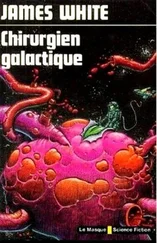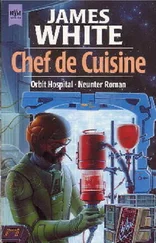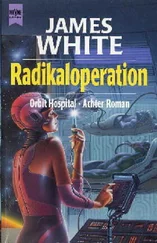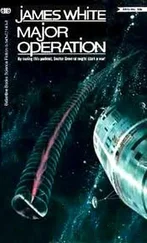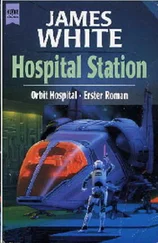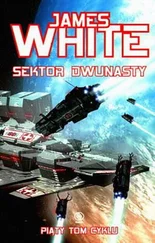“The difference in the extent and depth of the damage at this and the other crater,” he said. “You can see that this crater is shallower than the first one and, while the perimeter of this one has been fused by intense heat, the central area has been depressed but is not as badly burned. There is deep scratching that contains small traces of a brighter metal that is foreign to the surrounding hull. It looks as if a large, fairly smooth metal object made heavy contact at this spot. Friend Fletcher, the size and outline of the unburned area are suggestive.”
“You’ve got organic microscopes there instead of eyes, Doctor,” it said. “But suggestive of what? I’m seeing what you’re seeing, with great difficulty, but what should I be thinking about it?”
“Your pardon, friend Fletcher,” said Prilicla. “I cannot be absolutely certain without analyzing a specimen for purposes of comparison, but the traces of foreign metal you see suggests that this is where the alien robot we found on Terragar sustained its injuries or — since it was not an organic life-form — damage. The weapon or other agency which blew a crater in the front of its body, also blasted it backwards against the hull with the results you can see. Perhaps it was trying to protect its ship from something, or someone. If the crew were defenders rather than attackers their lethal assault on Terragar’s computer systems may have been due to a panic reaction following an earlier attack as ell as a simple, first-contact misunderstanding.”
“You could be right,” said the captain, “but I think you’re giving them the benefit of a very large doubt—” It reached towards the equipment satchel at its waist. “Grab my backpack and use your thrusters to hold me steady while I scrape off a specimen.”
“Friend Fletcher…!”
“Don’t worry, Doctor,” said the other, radiating reassurance as it produced a short, broad-bladed screwdriver. “This thing is too simple and stupid to be infected by a computer virus… Oops. That’s strange.”
While it had been scraping hard to remove the largest of the specimens, the tool’s sharp blade had penetrated the hull and torn out a narrow triangle of metal. It was surprisingly thin, structurally weak, and its underside was covered by the fine, geometrical shapes of integral circuitry. When it had bagged the original specimen, Fletcher removed the hull sample and placed it in an insulated box as a precaution against possible electronic infection. The captain’s accompanying feelings of impatience and barely controlled excitement suggested that it would rather be doing something else.
“I feel that you, too, have found something interesting, friend Fletcher,” said Prilicla. “What is it?”
'I don’t know,” the other replied. It secured the two specimens in its sample box before going on. “I had time for a quick look into what seems to be a long, thin and apparently empty compartment or corridor behind the access hatch. It would be easier to show you, Doctor. There’s enough room for both of us, and your extra helmet light will help us see whatever is in there, and, if necessary, make a fast retreat.”
Their lights showed a length of corridor leading inboard whose walls, except for a large cylindrical structure on one side that was enclosed by seamless metal plating that was warped and heat-discolored, were composed of a lightly-built, boxlike framework that appeared to be non-metallic. Continuous lengths of open-mesh netting were secured to and stretched tightly along all four inner surfaces of the framework and, about thirty meters inboard, a similar netted passageway intersected theirs at right angles. When the captain’s foot caught accidentally in the netting, the whole corridor vibrated for a moment before returning to stillness.
“That wall netting tells us one important fact about their level of technology,” said Fletcher, for the benefit of the recorder as well as Prilicla. “They don’t have artificial gravity. And look at the internal supporting structure of the hull. It reminds me of the interior of one of Earth’s old-time zeppelins — it’s just a light framework on which to hang a streamlined skin that will aid passage through a planetary atmosphere.”
“A skin,” Prilicla reminded it gently, “that your second specimen suggests could be one single, overall, multipurpose sensor.
“Yes, indeed,” Fletcher said. It pointed at the warped metal Under near them and went on. “I want to take a closer look at that later. From its size and shape I’d say that it houses one of a air of matched hyperdrive generators which malfunctioned, either by accident or through malicious intent, and caused them to detonate a distress beacon.”
Fletcher moved its vision pickup carefully so as to sight it inboard between the open mesh of the net. Prilicla pointed his helmet light in the same direction.
“Several more enclosed structures are visible,” it resumed. “All are solidly-built, some with complicated shapes and many projections which badly needed that streamlined outer hull. They appear to be joined to each other by a latticework of structural-support members. All of the ones we can see are linked together externally by short stretches of open-weave corridors like this one. But our point of entry, which may not be the only one, was by a simple, close-fitting, hinged cover that appears to allow access deep into the entire ship. It was not a pressurized seal, and nowhere can we see anything like an airlock.
“But then,” the captain added, allowing itself a small bark, 'a crew of intelligent robots wouldn’t need air.
“There is no obvious threat here at present,” it went on, “so I shall continue the investigation deeper inside the ship. In case of unforeseen developments, Doctor, would you like to remain here so that you can make a fast getaway?”
Prilicla was silent for a moment while common sense and 18 evolutionary imperative of survival through cowardice warred with the intensity of his curiosity, and lost.
“I would like to remain here,” he said, “but I won’t. Lead the way.”
The captain didn’t reply but its feelings regarding such stu-P «i behavior were very plain.
Slowly and carefully and with many pauses while Fletcher directed its vision pickup at objects that might or might not be of importance, they continued to move inboard while Fletcher described everything it saw and deduced in its flat, unemotional, observer’s voice.
Their helmet lights showed many cable looms running along the members that joined the large and small structures and mechanisms that were coming into view. Some of the cable runs were attached to the outer framework of the passages they were traversing, and clearly visible. The individual lengths were color-coded, their graduation in coloration and shading suggesting that the visual sensitivity of the ship’s crew was slightly higher than that of Prilicla’s Earth-human companion, but lower than his own. When they drew level with a large, blocky mechanism of indeterminate purpose with what was obviously a control panel and two access hatches on it, the captain’s curiosity became so intense that Prilicla felt obliged to issue a warning.
“No, friend Fletcher,” he said. “Look but don’t touch.”
“I know, I know,” it replied with a flash of irritation. “But how else can I find out what it is and does? I can’t believe that these people — robots or whatever — would plant a virus to booby-trap every internal control panel and hatch. That wouldn’t make sense. It would lead to a lot of unnecessary accidents among the crew.”
“The robot crew,” said Prilicla, “should be resistant to their ship’s computer viruses.”
“Good point,” said the captain. “But so far there has been no sign of them. Are they in their quarters? If so, what would the accommodations for a crew of robots look like?”
Читать дальше

